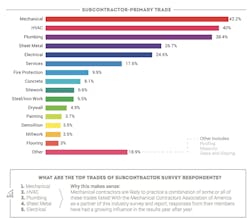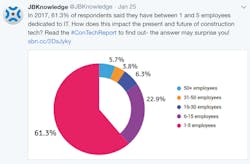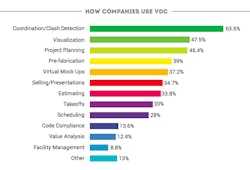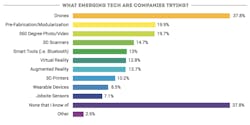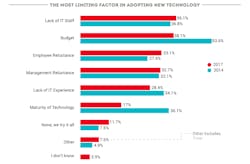When the Mechanical Contractors Association of America (MCAA) convenes its star-studded annual convention this March in San Antonio TX, attendees will hear from the likes of former First Lady Laura Bush, NBA Hall-of-Famer David Robinson, legendary newsman Ted Koppel and social scientist Malcolm Gladwell. One subject that writer/researcher Gladwell undoubtedly will address is the ongoing impact of technology on all of our lives.
After his insights, however, everyone there no doubt will return to their smart phones and resume not just their lives, but their jobs, as well. Because no matter where today’s modern managers and field techs may physically be, data shows that more and more of their work is being performed, reviewed, revised, and approved from the palms of their hands.
Measuring that change, and even driving it, has been a particular mission of Sean McGuire, MCAA’s director of construction technology and the national trade group’s tech evangelist. Now in his 18th year with MCAA, McGuire ratcheted up research efforts four years ago when he joined with the Construction Financial Management Association (CFMA) to sponsor the growing annual industry survey of JBKnowledge Inc. (JBK), which last month released the meaty findings of its Sixth Annual Construction Technology Report. Of note, Texas A&M University’s Construction Science Dept. has co-sponsored all six reports. To download a copy of the latest study, go to: https://jbknowledge.com.
“It really gives us a chance to dig deep and find out not only how are members are doing in adopting and using new technology, but how they compare to the rest of the industry, as well,” said McGuire (@MCAAGeek), speaking in a Feb. 9 webinar alongside JBKnowledge CEO James Benham. (Listen to the hour-long podcast summarizing the report’s findings here.)
Conducted last summer and released in January, results of the latest survey of contractors' technology practices and preferences will be colorfully presented by Benham in San Antonio. It is based on responses from nearly 2,700 construction professionals across the U.S., mixing general contractors, subcontractors, architects, engineers, and consultants. Among the subs participating, mechanical firms, HVAC, and plumbing contractors made up the majority, including 316 current MCAA members.
“Not all of the reports’ findings were intuitive,” said MCAA on its website, noting that respondents had reported using fewer apps now, in general, but doing so more often than before. “Two trends that are important for our industry involved prefabrication and building information modeling (BIM). The two concepts are intertwined as many MCAA members begin using BIM to improve their fabrication productivity and capabilities. Prefabrication use has risen over 12% from 2016, making it the second highest trend that all contractors are experimenting with.”
“This year, I also think we are going to see a real uptick in the use of 3D scanners,” added McGuire during the webinar. “And I would not be surprised at all to see an increase in the use of wearables, too. Barriers are coming down.”
BIM/VDC: Internal barriers continue to fall
Indeed, so many barriers are falling in so many areas. But the smaller the contractor, the likelier there will still be resistance to making the investment. “Based on our findings, the breakpoint for a full VDC (virtual design & construction) team is about $20 million in total revenue,” said Kelly Doyle, JBK’s SVP of Consulting, speaking to MCAA.org. “This is similar to the breakpoint for IT departments, as well. Once contractors hit that revenue volume, their overhead has the capacity to add more full-time staff to productivity improvements.”
According to the survey, only 27% of respondents reported having a dedicated BIM/VDC department last year. A “startling” 28% reported that their firms still will not bid on projects involving BIM. Another “unsettling revelation” is the 25% of respondents who reported only one or two colleagues even trained to work on BIM projects. But larger contractors are becoming more confident in maximizing their BIM capabilities. More companies are reporting that they now have BIM/VDC departments of more than two people.
“Unless builders make BIM a priority, they will fall behind BIM standards like those imposed in the UK when they come to the U.S.,” wrote Liz Welsh, JBK editor-in-chief for the report. “These standards will be arriving sooner rather than later and those poised for adoption will be the clear winners. The U.S. lacks a pipeline of experienced BIM staff to meet the inevitable future of demand.”
Added Benham, “The demand for BIM will continue as will BIM's influence on how construction projects are bid and won in 2018. Companies still not exploring BIM will find themselves more and more limited in areas of work.”
Drones, AI, Automation, Smart Tools, Sensors
Beyond BIM, Benham also makes several other observations in the 79-page report:
• The industry will continue to force business technology providers to match the efficiency, availability and low-cost we get from our consumer tech providers. Until then, contractors will opt to use personal devices and try personal solutions to solve short-term problems. Therefore, the lines will continue to blur between personal and corporate data, hardware and software. So data security will remain a key issue;
• Automation is here and will gain traction, whether companies and individuals embrace it is a matter of choice and education. Education around what "automation" means for each company is key. If more managers understood the work tasks that automation and Artificial Intelligence (AI) technologies can augment and enhance, they might focus less on the tasks they will “replace”;
• Workflows will be further digitized as companies mature and update processes, tinker with the latest mobile apps and devices, but they'll need integration capabilities to follow. Software and devices will continue to become more affordable, and with more technology options than ever before, companies are using fewer solutions than ever before to avoid the headache of integrating data across multiple solutions. To remain competitive, tech providers will have to continue to team up to get on contractors' short list of solutions that offer simplicity and data continuity;
• In 2018, we hope the trend in allocating more annual sales volume to IT continues and companies take concerted efforts to recapture costs from owners by learning how to allocate and justify technology per project. We hope to see dedicated IT staff grow, especially the role of a Construction Technologist for all IT and training needs. As outlined earlier in the report, a Construction Technologist is a team member who specializes in IT but with experience in construction to solve problems that costly, unspecialized third-party resources cannot.
BONUS EXCERPTS:
Are construction companies using Social Media?
In 2014, Forbes reported businesses with a social media presence experience stronger brand recognition, customer experience, inbound leads, and rates of conversion. Social media’s ability to bolster business credibility and build lead pipelines is common knowledge widely covered by mainstream media outlets. Perhaps one of the most sobering revelations in this year’s data is 25.5% of respondents still do not use any form of social media. Among respondents who are using social media, Facebook and LinkedIn are significantly more utilized than other social media platforms.
What is a Construction Technologist?
It’s important to note that 30.1% of companies this year are outsourcing a portion of IT. This presents an opportunity to scale resources for the company, but it creates the challenge of managing new vendors and processes. The industry has the opportunity to develop and make way for a Construction Technologist role within construction companies. This specialist can centralize and manage priorities and processes to drive innovation and return on investment. Their deep understanding of technology, construction, and business goals uniquely positions them for overall company success.
How about the 'Big Brother' factor? (Not the TV show.)
To download the entire new report, and compare with prior research, go to https://jbknowledge.com.










